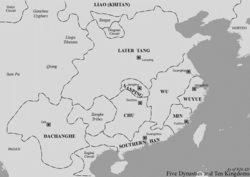Jingnan
Jingnan (simplified Chinese: 荆南; traditional Chinese: 荊南; pinyin: Jīngnán), also known as Nanping (南平; alternatively written as Southern Ping[1]) and Northern Chu (北楚) in historiography, was one of the Ten Kingdoms in south-central China created in 924, marking the beginning of the Five Dynasties and Ten Kingdoms period (907–960).
Jingnan (Nanping) 荆南 (南平) | |||||||||
|---|---|---|---|---|---|---|---|---|---|
| 924–963 | |||||||||
 Jingnan (Nanping) shown on map | |||||||||
| Capital | Jingzhou | ||||||||
| Common languages | Middle Chinese | ||||||||
| Government | Monarchy | ||||||||
| King | |||||||||
• 909–928 | Gao Jixing | ||||||||
• 928–948 | Gao Conghui | ||||||||
• 948–960 | Gao Baorong | ||||||||
• 960–962 | Gao Baoxu | ||||||||
• 962–963 | Gao Jichong | ||||||||
| Historical era | Five Dynasties and Ten Kingdoms Period | ||||||||
• Established | 924 | ||||||||
• Ended by the Song Dynasty | 963 | ||||||||
| |||||||||
| Today part of | China | ||||||||
Founding
Gao Jichang, also known as Gao Jixing (高季興), was appointed the regional military governor of Jiangling in 907 by the Later Liang, which took over northern China in the wake of the Tang Dynasty. He declared the foundation of the Kingdom of Jingnan (or Nanping) in 924 after the Later Liang fell to the Later Tang.
Territorial Extent
Jingnan was the smallest of the longer-lived southern kingdoms. Its capital was Jiangling, and in addition to the capital, it held two neighboring districts on the Yangtze River southwest of present-day Wuhan. In addition to bordering the succession of five dynasties beginning with the Later Tang, it also shared borders with the Chu kingdom to the south, though that was replaced by the Southern Tang when it absorbed the kingdom in 951. It was also bordered by the Later Shu on the west after it was formed in 934.
Importance
Jingnan was a small and weak state, and in many ways was vulnerable to its larger, more powerful neighbors. As such, the court placed great importance in maintaining proper relations with the succession of dynasties that ruled northern China. However, because of its location, Jingnan was a central hub in trade, a feature that protected it from invasion.
Fall of the Kingdom
The Song Dynasty was formed in 960, ending the Five Dynasties period in the north, and though that is the date traditionally used to denote the end of the Five Dynasties and Ten Kingdoms period, many kingdoms in the south maintained their independence for nearly two decades after the rise of the Song Dynasty. However, due to its size and location, Jingnan was the first of the kingdoms to succumb to the Song Dynasty, surrendering when armies from the north invaded in 963, ending the kingdom.
Rulers
| Temple Names ( Miao Hao 廟號 miao4 hao4) | Posthumous Names ( Shi Hao 諡號) | Personal Names | Period of Reigns | Era Names (Nian Hao 年號) and their according range of years |
|---|---|---|---|---|
| Did not exist | Prince Wuxin (武信王) | Gao Jixing (高季興) | 909–928 | Did not exist |
| Did not exist | Prince Wenxian (文獻王) | Gao Conghui (高從誨) | 928–948 | Did not exist |
| Did not exist | Prince Zhenyi (貞懿王) | Gao Baorong (高保融) | 948–960 | Did not exist |
| Did not exist | Prince Zhenan (貞安王) | Gao Baoxu (高保勗) | 960–962 | Did not exist |
| Did not exist | Prince Deren (德仁王) | Gao Jichong (高繼沖) | 962–963 | Did not exist |
Rulers family tree
| Rulers family tree | |||||||||||||||||||||||||||||||||||||||||||||||||||||||||||||||||||||||||||||||||||||||||||
|---|---|---|---|---|---|---|---|---|---|---|---|---|---|---|---|---|---|---|---|---|---|---|---|---|---|---|---|---|---|---|---|---|---|---|---|---|---|---|---|---|---|---|---|---|---|---|---|---|---|---|---|---|---|---|---|---|---|---|---|---|---|---|---|---|---|---|---|---|---|---|---|---|---|---|---|---|---|---|---|---|---|---|---|---|---|---|---|---|---|---|---|
| |||||||||||||||||||||||||||||||||||||||||||||||||||||||||||||||||||||||||||||||||||||||||||
References
- Dillon, Michael (2016). Encyclopedia of Chinese History.
- Mote, F.W. (1999). Imperial China (900-1800). Harvard University Press. pp. 11, 16. ISBN 0-674-01212-7.
External links
- Ulrich Theobald. "Chinese History - Ten States 十國 - Jingnan 荊南 (Nanping 南平) (www.chinaknowledge.de)". chinaknowledge.de. Retrieved 2015-07-11.